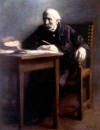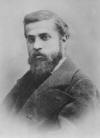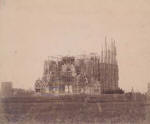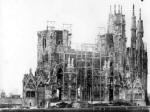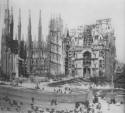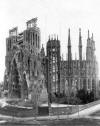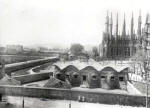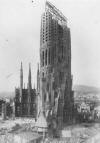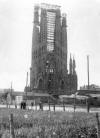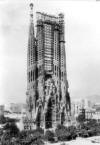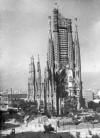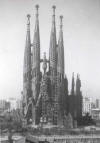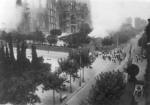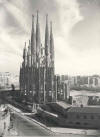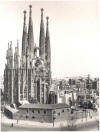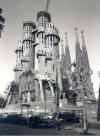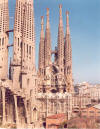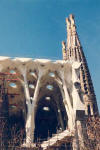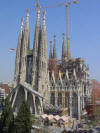Sagrada Familia – Chronology
Portrait of Josep
M. Bocabella i Verdaguer
Placement of the Sagrada Familia foundation stone
Gaudí when he tacked in charge
the temple works
The apse and the back of the
Nativity façade in 1904
1910 – The apse and the schools
1913 – The bell towers and the
apse
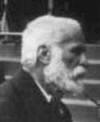
Gaudí in the Corpus procession
1925 – The bell towers near to
be finished
1926 – Year of the Gaudí death,
Saint Barnabas tower finished
Year 1933
The Nativity façade finished
Year 1936 – The schools and
plans burned and the models destroyed
1866 – Josep Maria Bocabella, the promoter of the Sagrada Família temple, found the Association of Saint Joseph Devout, with the aim to build the temple.
1876 – Bocabella begins to seek a lot in Barcelona to build the temple. Gaudí collaborates with architect Francesc de Paula Villar – that later will be the first architect of the Sagrada Família -, carrying out as designer the project of the chapel of the Virgin and the apse of the Monastery of Montserrat.
1881 –
The land for the construction of the Sagrada Família is acquired. The
architect Francesc de Paula i Villar takes charge of the works of
construction.
1882 – The foundation stone of the temple is placed the Saint Joseph day, a little later, the construction of the crypt according to the project of Francesc de Paula i Villar begins. Gaudí was not still linked to the project.
Gaudí works as a assistant of the architect Joan Martorell in the projects of the churches of the Jesuits of Casp street and the Saleses in Sant Joan Promenade in Barcelona.
1883 – Francesc da Paula i Villar resigns as the director of the project by discrepancies with the architect Martorell member of the Council that also intervened in the project and Josep Maria Bocabella. November 3, Gaudí succed Francesc de Paula Villar i Lozano as the architect of the Sagrada Família, under the suggestion of the architect Joan Martorell.
1884 – March 28, Gaudí sign the first official document as the architect of the Sagrada Família.
1885 – Gaudí carries out the first plan project of the Sagrada Família. He carries out an altar, a shrine and a sacrarium for the promoter of the temple Josep Bocabella.
1886 -He finishes the construction of the seven chapels of the Crypt of the Sagrada Família.
1887 – He builds the building of the vicarage of the Sagrada Família, in which he prepare his work space and where he will live the last years of his life.
1889 – The crypt of the Sagrada Família is finished and the construction of the apse begins.
1891 – Gaudí begins to study the Nativity façade.
1892 – The construction of the Nativity façade of the Sagrada Família begins. The apse already is very advanced, the gargoyles and the clerestories are built. April 22, Josep Maria Bocabella promoter of the temple dies.
1893 – The crypt and the apse are finished.
Gaudí carries out the project of the Colonia Güell crypt in Santa Coloma de Cervelló.
1894 – The façade of the apse is finished.
1895 – The construction of the cloister of the Sagrada Família is started.
The bishop Català names a new Council for the work of the temple presided by Mn. F. Millán
1897 – The works are progressing well, 112 people is working in the temple .
1898 – Gaudí begins the first outlines of the Passion façade. The Rosary entry large central window is placed as other elements of the whole.
1899 – Several sculptures of the Nativity façade are placed like the angels playing clarions, Saint John, Saint Zachariah, Saint Joachim and Saint Anna. An organ with a gas engine is started.
1900 – The central stone archivolt is finished.
1901 – The large central window with 20 figures is finished as other smaller works.
1905 – The bell tower of Saint Barnabas gets the 44 meters of height.
1906 – The bell tower of Saint Mathew gets the 44 meters of height.
1908 – Start of the works of the Colònia Güell crypt where Gaudí
will investigate many of the technical solutions that later he will apply in the Sagrada Família.
The cardinal Casanyes, protector of the temple and friend of his promoter Josep Maria Bocabella dies.
A model of the Nativity façade financed by the Count Güell and decorated by
Jujol is presented in the Architecture show of the Fine Arts Exhibition of Paris.
1909 – As a result of the “Tragic week” in Barcelona, several churches are burned.
Construction of the Schools of the Sagrada Família to the side of the temple.
1910 – Models of the works in gypsum by Gaudí are exposed in the Grand Palais of Paris in April 15 to 30 of June, with a great success.
1911 – Gaudí sick of Malta fevers. To be cured he comes to Puigcerdà. It does his testament.
The Cardinal Vives i Tutó gives to the temple a big quantity of relics.
1912 – The bell towers get the height of 66 meters.
1914 – The works are faced to important economic problems, only 30 people is working in it. Only the tenacity of Gaudí permits to continue the works.
The bell towers get the 70 meters of height.
The President of the Mancomunitat (Regional government) of Catalonia Enric Prat de la Riba visits the temple.
Gaudí rejects new assignments and concentrates on the construction of the Sagrada Família.
1915 – The cardinals Torres i Bages and Pla i Deniel carry out extraordinary subscriptions to be able to continue the temple. Aids of businesses are received.
The papal nuncio of the Holy See Monsignor Ragonesi visits the temple.
The tests of the tubular bells are done.
1916 – The bishop Torres i Bages dies, Gaudí does a study on the possibility to create tombs inside the Sagrada Família. Gaudí asks for aids the merchants of Barcelona.
1917 – Gaudí designs the Passion façade, including a monument to the
Bishop Torres i Bages.
1918 – Eusebi Güell i Bacigalupi, count Güell, that had been the great sponsor of Gaudí, dies in
his residence of the Park Güell.
The basements of the bell towers are finished of Saint Mary and San Barnabas.
Hyperboloids in the models of the large windows.
1920 – Le Corbusier visit in Barcelona the works of the Sagrada Família, that he qualifies as master work.
A new model of the sacristy is begin.
1922 – The sacristies models are finished as the interior models of columns and vaults.
The outlines of the Glory façade are begin.
The bell towers get the height of 82 meters.
1923 – The gypsum models of the nave and the ceiling are carried out in scales 1/10 and 1/25
1924 – The sculptural group in stone of the Slaughter is placed.
Gaudí is under arrest September 11 (national Day of Catalonia) to attend in the church of the Saints Just i Pastor in Barcelona to the mass in memory of the Catalonian patriots and to refuse to speak in Spanish to the police.
The study of one of the pulpits is carried out.
1925 – Gaudí come to live inside the precinct of the Sagrada Família to be able to
follow closer the works.
November 30 the bell tower of Saint Barnabas is finished.
1926 – The Venetian mosaic for the north bell tower is received.
Gaudí been knocked down in the crossing of the Gran Via Avenue and Bailèn street of Barcelona by a trolley June 7. In consequence of the injuries he dies on the 10 in the Hospital of the Holy Cross and he is buried in the Crypt of the Sagrada Família on the 12.
1927 – The works of the temple are followed despite the death of Gaudí.
1930 – The four bell towers of the Nativity façade are finished.
1932 – The construction of the cypress of the central pinnacle begins.
1933 – The pinnacle of the Faith is finished.
1935 – The figures and the flashlight of the Hope and the flashlight of the Faith are finished.
1936 – Subsequently of the military coup that initiates the civil war
1936-1939, revolutionary groups burn the crypt, the Schools and the workshop of Gaudí where they break the scaled gypsum models.
1939 – The war finished, the restoration of the crypt is begin.
The architect Francesc Quintana and other collaborators, restore the models that will serve for restarting the temple construction.
1948 – The works to mount the South transept large window are taken up again with remained stones already prepared.
1952 – In occasion of the Barcelona International Eucharistic Congress, the flight of steeps of the
Nativity façade is built and the temple is illuminated.
1953 – The Council decides to build the Passion façade.
1954 – The Passion façade works begin, under the direction of the architects Quintana, Puig Boada and Bonet Garí.
1957 – The chapel of the crypt Baptistery is finished.
1958 – The Saint Joseph day, the group of the Birth of the sculptor J. Busquets is placed on the genealogical column.
The walls of the basement of the bell towers of the Passion façade begin to be
built.
1961 – The Gaudí Museum is initiated into the crypt of the Passion façade.
1964 – The “conciliabuls” (literally places to speak quietly and secretly) are finished.
1965 – A carillon is installed. The elevator of the Nativity façade is inaugurated.
1966 – The group of the Annunciation by the sculptor J. Busquets is placed.
The bell towers of the Passion façade arrive at a height of 24 meters.
June 28 the architect Francesc Quintana, who was so decisive in the recovery of the necessary material by the continuation of the works of the temple, dies.
1967 – The bell towers of the Passion façade arrive at the height of 30 meters and the columns of the portico to the 9 meters.
1970 – The bell towers of the Passion façade already arrive at the 46 meters and the columns of the portal under the level of the capitals.
1976 – In the 50 anniversary of the death of Gaudí and concretely
November 9, the Passion façade with the culmination of the pinnacles
of the four bell towers is finished.
1978 – The works begin of the naves walls.
1986 – The foundation of the naves begin.
1990 – The first sculptures by Josep Maria Subirachs are placed in the Passion façade.
1995 – Construction of the lateral naves vaults.
1998 – The construction of the central nave vaults begins.
2000 – The construction of the central nave vaults is finished.
2001 – The four columns of porphyry of the main altar in the centre of the transept are built.
The large central window of the Passion façade is built.
2002 – Works are in progress in the transept and apse vaults to close the interior space of the temple.
Extract of the last report of the Architect Director of the works Jordi Bonet: To December 2004 and according to a report of the architect director of the works Jordi Bonet i Armengol, that we summarize in very general terms, the state of the works at present in motion is the following one:
Crypt: Restoration and finishing works.
Apse: the vaults of the central chapels of the apse are being carried
out, the columns are to a height of 30 meters. The capitals of the columns of Saint Peter and Saint Paul are placed as the capitals of the eight columns of backup of the hyperbolic vault of the Virgin spire.
Passion façade: The walls of the patriarchs and the prophets raise above the basalt cornice. The Ascent sculpture in bronze of 5 meters long is on the gild process before installing it in its location to 60 meters of height.
Transept: the vaults are near to be closed to be able to build quick the two pending sections of the transept. The banister of 45 meters of the clerestory is very advanced and those of the vaults of the evangelists Marc and Lucas are being built to 55 m. what will permit to raise the vaults of the transept and the apse.
In July the large window upper with the Nativity side of the transept rose window, work of Vila-Grau was finished.
Cloisters: the closing glasses have been installed as the stone flooring. New furniture is prepared.
The access ramp from Mallorca and Sardenya street has been opened.
Vaults and central nave roof: Four of the pinnacles already are crowned by Eucharistic symbols.
Glory façade: The concrete structure of the Jube clerestory has been completed to 9 meters on the temple floor as other complementary works.
Other Works of Gaudí
In Barcelona: Bellesguard | Eduard Calvet House | Batlló House | Vicens House | Santa Teresa School | Sagrada Família Schools | La Pedrera | Güell Pavilions | Güell PalacePark Güell | Sagrada Família | Miralles Property Fence
In La Pobla de Lillet: Catllaràs Villa | Artigas Gardens
In Mataró: Workers Cooperative building (attributed)
In Montserrat: Monumental Rosary path (1st mystery of Glory)
In Santa Coloma de Cervelló: Colònia Güell Crypt
In Garraf (Sitges): Garraf Cellars
Out of Catalonia: Botines House (León) | El Capricho (Comillas) | Episcopal Palace (Astorga)

